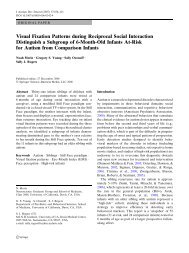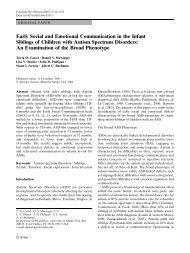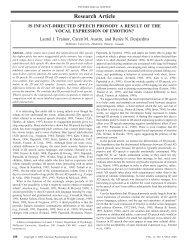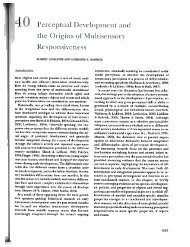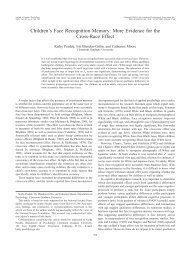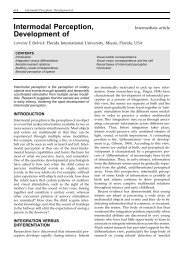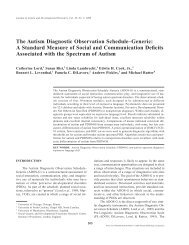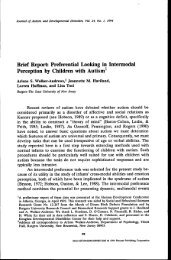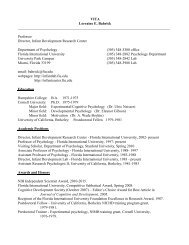The role of the mother's voice in developing mother's ... - FIU Infant Lab
The role of the mother's voice in developing mother's ... - FIU Infant Lab
The role of the mother's voice in developing mother's ... - FIU Infant Lab
Create successful ePaper yourself
Turn your PDF publications into a flip-book with our unique Google optimized e-Paper software.
46<br />
F. Z. Sai<br />
<strong>voice</strong> with positive re<strong>in</strong>forcers such as <strong>the</strong> sight <strong>of</strong> <strong>the</strong> mo<strong>the</strong>r. Conversely,<br />
preference for <strong>the</strong> mo<strong>the</strong>r’s face is likely to be rooted <strong>in</strong> foetal exposure to <strong>the</strong><br />
mo<strong>the</strong>r’s speech (Decasper and Spence, 1991; Turkewitz, 1988; Richards et al.,<br />
1992). A grow<strong>in</strong>g body <strong>of</strong> evidence has demonstrated <strong>the</strong> function<strong>in</strong>g <strong>of</strong> foetal<br />
sensory systems dur<strong>in</strong>g gestation, as well <strong>the</strong> sequential functional development<br />
<strong>of</strong> sensory systems (for review, see Lecanuet and Schaal, 1996). <strong>The</strong> auditory<br />
system develops much earlier than <strong>the</strong> visual system (Gottlieb, 1971), and healthy<br />
full-term human foetuses respond to a wide variety <strong>of</strong> sounds and vibrations<br />
orig<strong>in</strong>at<strong>in</strong>g from outside <strong>the</strong> womb (Birnholz and Benaceraf, 1983; Kisilevsky and<br />
Muir, 1991; Lecanuet et al., 1986; Seraf<strong>in</strong>i and L<strong>in</strong>dsay, 1984). As well, FHR and<br />
movements to vibroacoustic stimulation were reported <strong>in</strong> foetuses as early as 26<br />
weeks gestation (Kisilevsky et al., 1992). Data from studies on uterus speech<br />
transmission performed with a hydrophone near <strong>the</strong> foetal head dur<strong>in</strong>g delivery,<br />
have revealed a significant better transmission <strong>of</strong> <strong>the</strong> maternal <strong>voice</strong> than <strong>of</strong> <strong>the</strong><br />
external <strong>voice</strong> (Querleu et al., 1988). We also know that <strong>the</strong> mo<strong>the</strong>r’s <strong>voice</strong> is <strong>the</strong><br />
only auditory stimulus that is transmitted <strong>in</strong>ternally via body tissues and bones<br />
(Petitjean, 1989); it also <strong>in</strong>volves diaphragmatic movements generat<strong>in</strong>g pressure<br />
changes <strong>in</strong> <strong>the</strong> fluid medium <strong>of</strong> <strong>the</strong> uterus. Also, prenates <strong>of</strong> mo<strong>the</strong>rs who<br />
listened to ‘soap opera’ <strong>the</strong>me music dur<strong>in</strong>g pregnancy showed a preference for<br />
<strong>the</strong> same music dur<strong>in</strong>g <strong>the</strong> postnatal period (Hepper, 1988). <strong>The</strong> longer <strong>the</strong><br />
prenatal exposure <strong>of</strong> human neonates, liv<strong>in</strong>g <strong>in</strong> <strong>the</strong> Osaka airport neighbourhood,<br />
to airplane noises, <strong>the</strong> better <strong>the</strong>y slept compared to babies whose mo<strong>the</strong>rs<br />
had lived <strong>in</strong> <strong>the</strong> area <strong>of</strong> <strong>the</strong> airport for shorter times dur<strong>in</strong>g pregnancy (Ando and<br />
Hattori, 1977). <strong>The</strong> work <strong>of</strong> DeCasper and Fifer (1980), DeCasper and Spence<br />
(1986), DeCasper and Prescott (1984) reveals a complexity <strong>of</strong> bond<strong>in</strong>g and<br />
language process<strong>in</strong>g dur<strong>in</strong>g <strong>the</strong> prenatal period. Given that <strong>the</strong> presence <strong>of</strong><br />
potential sensory stimulation <strong>in</strong> <strong>the</strong> foetal milieu as well <strong>the</strong> presence <strong>of</strong> foetal<br />
sensory sensitivity to acoustic (e.g. Lecanuet et al., 1995) and vibroacoustic (e.g.<br />
Kisilevsky, 1995) stimuli, and <strong>the</strong> cont<strong>in</strong>uity <strong>of</strong> foetal and newborn response to<br />
sound and vibration, it is, <strong>the</strong>refore, possible that neonates are born with a longterm<br />
memory for <strong>the</strong> mo<strong>the</strong>r’s <strong>voice</strong>.<br />
However, <strong>the</strong> question whe<strong>the</strong>r <strong>the</strong> neonates rapidly associate <strong>the</strong> mo<strong>the</strong>r’s<br />
<strong>voice</strong>–face at birth, or demonstrate a long-term memory effect for <strong>the</strong> mo<strong>the</strong>r’s<br />
<strong>voice</strong> learned while <strong>the</strong> foetus was still <strong>in</strong> <strong>the</strong> mo<strong>the</strong>r’s womb rema<strong>in</strong>s<br />
unanswered. Never<strong>the</strong>less, data from one <strong>of</strong> our studies <strong>in</strong> which newborn<br />
<strong>in</strong>fants were exposed to both <strong>the</strong> mo<strong>the</strong>r’s <strong>voice</strong> and face, among o<strong>the</strong>rs, show<br />
that mo<strong>the</strong>r preference was stronger with shorter delays than with longer delays<br />
between last exposure to <strong>the</strong> mo<strong>the</strong>r and preference test<strong>in</strong>g (Sai, 1990), <strong>in</strong>dicat<strong>in</strong>g<br />
that learn<strong>in</strong>g <strong>the</strong> mo<strong>the</strong>r’s face is very stable and established as a long-term<br />
memory. <strong>The</strong> mo<strong>the</strong>r’s <strong>voice</strong>–face association seems, <strong>the</strong>refore, to take place at<br />
least shortly after <strong>the</strong> <strong>in</strong>fant’s birth.<br />
<strong>The</strong>se f<strong>in</strong>d<strong>in</strong>gs replicate and extend our previous research suggest<strong>in</strong>g a rapid<br />
learn<strong>in</strong>g <strong>of</strong> <strong>the</strong> mo<strong>the</strong>r’s face at birth. Such learn<strong>in</strong>g, however, vanished when a<br />
previous exposure to <strong>the</strong> mo<strong>the</strong>r’s <strong>voice</strong>–face comb<strong>in</strong>ations (Exps 2 and 4) was<br />
made unavailable to neonates from birth through test<strong>in</strong>g. A prior exposure to <strong>the</strong><br />
mo<strong>the</strong>r’s <strong>voice</strong>–face comb<strong>in</strong>ation rema<strong>in</strong>s, <strong>the</strong>refore, a significant predictor <strong>of</strong> <strong>the</strong><br />
mo<strong>the</strong>r’s face recognition at least with<strong>in</strong> <strong>the</strong> first days <strong>of</strong> birth. We still do not<br />
know precisely what visual features, <strong>the</strong> newborns associated to <strong>the</strong> mo<strong>the</strong>r’s<br />
<strong>voice</strong> <strong>in</strong> order to make <strong>the</strong>ir preferential choices. Never<strong>the</strong>less, <strong>the</strong> results<br />
strongly suggest an <strong>in</strong>termodal learn<strong>in</strong>g at birth, probably facilitated by a longterm<br />
memory for <strong>the</strong> mo<strong>the</strong>r’s <strong>voice</strong> learned <strong>in</strong> <strong>the</strong> conf<strong>in</strong>es <strong>of</strong> <strong>the</strong> womb. One<br />
<strong>in</strong>terest<strong>in</strong>g direction for future research concerns <strong>the</strong> amount <strong>of</strong> exposure to <strong>the</strong><br />
Copyright # 2004 John Wiley & Sons, Ltd. Inf. Child Dev. 14: 29–50 (2005)



